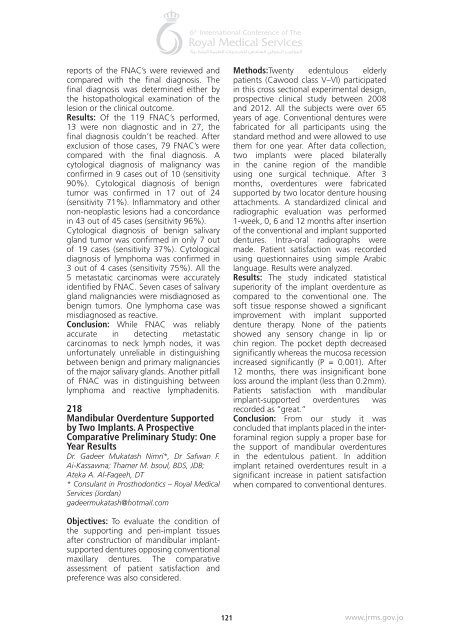Abstract book 6th RMS 16.indd
Abstract book 6th RMS 16.indd
Abstract book 6th RMS 16.indd
You also want an ePaper? Increase the reach of your titles
YUMPU automatically turns print PDFs into web optimized ePapers that Google loves.
eports of the FNAC’s were reviewed and<br />
compared with the final diagnosis. The<br />
final diagnosis was determined either by<br />
the histopathological examination of the<br />
lesion or the clinical outcome.<br />
Results: Of the 119 FNAC’s performed,<br />
13 were non diagnostic and in 27, the<br />
final diagnosis couldn’t be reached. After<br />
exclusion of those cases, 79 FNAC’s were<br />
compared with the final diagnosis. A<br />
cytological diagnosis of malignancy was<br />
confirmed in 9 cases out of 10 (sensitivity<br />
90%). Cytological diagnosis of benign<br />
tumor was confirmed in 17 out of 24<br />
(sensitivity 71%). Inflammatory and other<br />
non-neoplastic lesions had a concordance<br />
in 43 out of 45 cases (sensitivity 96%).<br />
Cytological diagnosis of benign salivary<br />
gland tumor was confirmed in only 7 out<br />
of 19 cases (sensitivity 37%). Cytological<br />
diagnosis of lymphoma was confirmed in<br />
3 out of 4 cases (sensitivity 75%). All the<br />
5 metastatic carcinomas were accurately<br />
identified by FNAC. Seven cases of salivary<br />
gland malignancies were misdiagnosed as<br />
benign tumors. One lymphoma case was<br />
misdiagnosed as reactive.<br />
Conclusion: While FNAC was reliably<br />
accurate in detecting metastatic<br />
carcinomas to neck lymph nodes, it was<br />
unfortunately unreliable in distinguishing<br />
between benign and primary malignancies<br />
of the major salivary glands. Another pitfall<br />
of FNAC was in distinguishing between<br />
lymphoma and reactive lymphadenitis.<br />
218<br />
Mandibular Overdenture Supported<br />
by Two Implants. A Prospective<br />
Comparative Preliminary Study: One<br />
Year Results<br />
Dr. Gadeer Mukatash Nimri*, Dr Safwan F.<br />
Ai-Kassawna; Thamer M. bsoul, BDS, JDB;<br />
Ateka A. Al-Faqeeh, DT<br />
* Consulant in Prosthodontics – Royal Medical<br />
Services (Jordan)<br />
gadeermukatash@hotmail.com<br />
Methods:Twenty edentulous elderly<br />
patients (Cawood class V–VI) participated<br />
in this cross sectional experimental design,<br />
prospective clinical study between 2008<br />
and 2012. All the subjects were over 65<br />
years of age. Conventional dentures were<br />
fabricated for all participants using the<br />
standard method and were allowed to use<br />
them for one year. After data collection,<br />
two implants were placed bilaterally<br />
in the canine region of the mandible<br />
using one surgical technique. After 3<br />
months, overdentures were fabricated<br />
supported by two locator denture housing<br />
attachments. A standardized clinical and<br />
radiographic evaluation was performed<br />
1-week, 0, 6 and 12 months after insertion<br />
of the conventional and implant supported<br />
dentures. Intra-oral radiographs were<br />
made. Patient satisfaction was recorded<br />
using questionnaires using simple Arabic<br />
language. Results were analyzed.<br />
Results: The study indicated statistical<br />
superiority of the implant overdenture as<br />
compared to the conventional one. The<br />
soft tissue response showed a significant<br />
improvement with implant supported<br />
denture therapy. None of the patients<br />
showed any sensory change in lip or<br />
chin region. The pocket depth decreased<br />
significantly whereas the mucosa recession<br />
increased significantly (P = 0.001). After<br />
12 months, there was insignificant bone<br />
loss around the implant (less than 0.2mm).<br />
Patients satisfaction with mandibular<br />
implant-supported overdentures was<br />
recorded as ‘‘great.’’<br />
Conclusion: From our study it was<br />
concluded that implants placed in the interforaminal<br />
region supply a proper base for<br />
the support of mandibular overdentures<br />
in the edentulous patient. In addition<br />
implant retained overdentures result in a<br />
significant increase in patient satisfaction<br />
when compared to conventional dentures.<br />
Objectives: To evaluate the condition of<br />
the supporting and peri-implant tissues<br />
after construction of mandibular implantsupported<br />
dentures opposing conventional<br />
maxillary dentures. The comparative<br />
assessment of patient satisfaction and<br />
preference was also considered.<br />
121 www.jrms.gov.jo

















